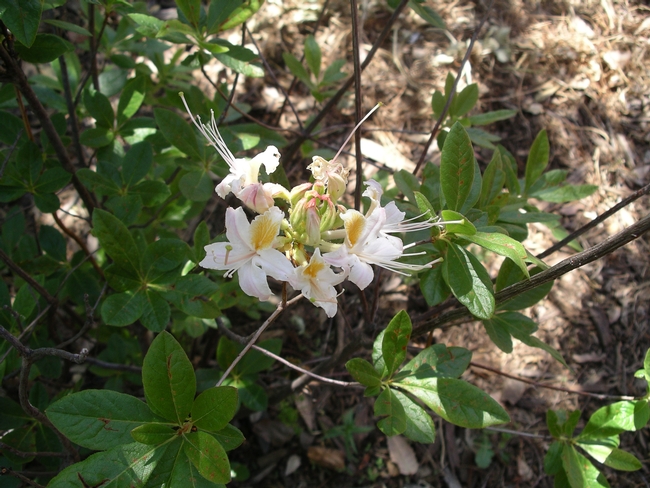By Cindy Weiner, Butte County Master Gardener, May 30, 2014
It can be difficult to find plants that bloom in shade. Incorporating native plants in your garden can greatly increase the choices available to you.
One plant suitable for dry shade is Catalina perfume or evergreen currant (scientific name Ribes viburnifolium). Native to Catalina Island and Baja California, it is a small evergreen shrub with glossy dark green leaves that have a spicy fragrance. The arching red stems reach 3 feet tall and spread about 6 feet. Pruning the stem tips will increase the density of the plant. Small rose-colored flowers appear from February to April. The fruit, a reddish-orange berry, isn't commonly seen in garden settings. While Catalina perfume needs no supplemental water once established, it can tolerate more, so it can be grown alongside plants with greater water requirements.
Coral bells and alum roots in the genus Heuchera are herbaceous perennials native to North America. Their large lobed leaves on long stems are evergreen, making the foliage attractive all year. They have tiny bell-shaped flowers held above the leaves in airy sprays on long stems. These plants look especially nice growing in drifts under trees. They grow well in filtered or part shade and require only occasional to moderate water. Their woody rootstocks should be divided or cut back to short stubs every 3-4 years.
Island alum root (Heuchera maxima) is native to the Channel Islands. It grows one to three feet tall and has creamy white to pinkish flowers. Crevice alumroot (Heuchera micrantha) grows on rocky mountain outcrops from central California north to Oregon. It is smaller than island alum root and its flowers are white or pink. Many cultivars of crevice alum root are available in general nurseries. These cultivars have been selected for foliage with silvery, bronze or purple tones. Three of the cultivars are “painted lady,” “Blessingham bronze,” and “purple palace.”
Many local gardeners enjoy growing azaleas for their beautiful flowers in the spring, but few grow the equally beautiful western azalea (scientific name Rhododendron occidentale). It is native to the coastal ranges and the west side of the Sierra Nevada and Cascade mountains of California and Oregon, including Butte County, where it grows along streams or in other moist areas. In fact, a dried specimen of western azalea collected in Cherokee by Annie Bidwell in 1879 is housed in the herbarium of Harvard University. Western azalea blooms in May and June, later than other azaleas, and has large white or pinkish flowers with a yellow blotch on the top petal. The long stamens extend beyond the flower. Unlike other azaleas, the flowers are fragrant. Western azalea blooms best in filtered or part shade; it will grow in full shade, but blooms will be sparse. Too much sun will burn the foliage. The leaves are deciduous, turning yellow in the fall. At maturity it can reach up to ten feet in height. Like other azaleas, it requires acid or neutral soil and routine irrigation during the dry season. Western azalea makes a worthy companion for other acid-loving plants in the garden.


